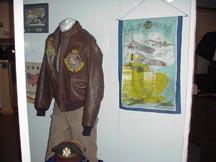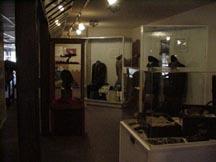Notice: Use of this site constitutes
your acceptance of these Terms of Use.
St Hubert, the Seiber
Islands

The USAF Consular Support Buildings
These “temporary” buildings were constructed by the United States Army Air Corps during World War II. Visitors note that the trees and other vegetation around these buildings is distinctly "foreign". Indeed, the plants are native to the United States and give this part of the museum a distinctly "American" look.
The building pictured above houses the adminstrative offices of the museum on the second floor. The first floor is dedicated to exhibits reflecting the American Air Force's presence in the Seiber Islands since 1941.



The other building is the location of the original "Corky's Office"1. It now houses a snack bar and gift shop. A banquet room is available for special events and is especially suitable for reunions.

If you wish to schedule a special event here, please contact us.
1 The
pub was named after the original “Corky’s Office”, which was
located in one of the Museum’s USAF Consular Support
Buildings. This is the “official” story of how the office got
its name:
After Corky McCorkle’s
release from a Japanese POW camp and return to the Seiber
Islands, Jake Cutter made him Chief of Maintenance and
Operations of the Seiber Islands Division of WOAC (now Seiber Airlines). However, it soon
became apparent that Corky had not recovered enough from his
time as a POW to serve in that very demanding position.
In early 1946, Jake
regretfully asked Corky to step down as M&O Chief and,
still reporting directly to him, take charge of the Division’s
“reserve” aircraft. Corky was assigned a small crew of
mechanics and an unused hanger and couple of other temporary
buildings which had been built and used by the U.S. Army Air
Corps during WWII. Fortuitously,
their first task involved a WOAC Branta—a plane
very similar to Cutter’s
Goose —and Corky proved not only that he had lost none
of pre-war skills as a hands-on mechanic, but could be an
effective leader as well.
The original “Corky’s
Office” was, in fact, just his office. But it did just
happened to be in the same building as what had been the
American’s Officers’ Club.
During the late 1940’s and 1950’s, the old Club was
occasionally used by Corky and his employees as a place to
have a short celebration on the successful conclusion of a
difficult project. It
also became the place to store and display various “artifacts”
recovered from aircraft they had worked on, e.g., a propeller
from Cutter’s Goose
and a brass monkey found stuffed in a space in the aft of Cutter’s Goose which
appeared identical to the one in the famed Monkey
Bar.
In 1966, Corky retired
from WOAC, just after overseeing the construction of new
maintenance facilities at the airport. Upon retirement, he
joined the Seiber Islands Aero Museum (now the Cutter Air
Museum), becoming its first Chief of Aircraft Maintenance and
Restoration. Jake
arranged to have the U.S. buildings (along with their
artifacts, equipment, as well as a number of WOAC’s “reserve”
aircraft) transferred to the Aero Museum at that time.
Updated 05/22/14